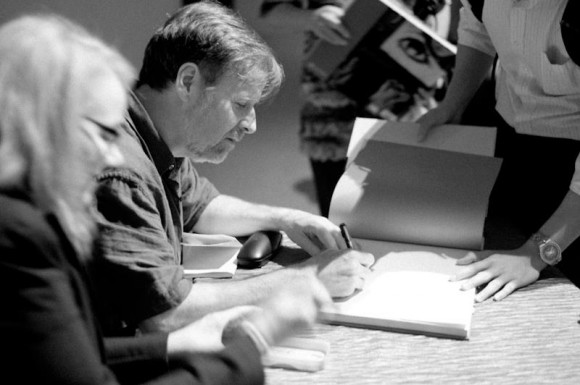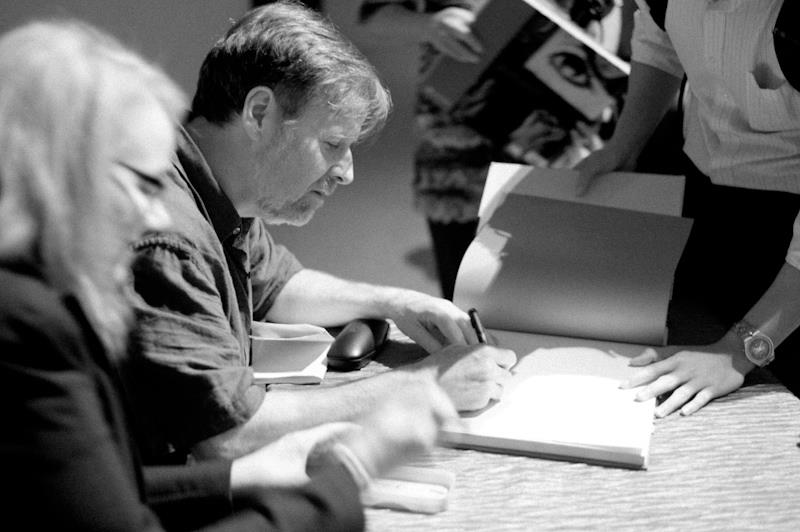Part 2 transcription of the Q&A session during the public talk given by photographers Alex Webb and Rebecca Norris Webb and David Chickey of Radius Books, at The National Museum Of Singapore on 9th March, 2012.

Seeing in Color
Question: I noticed that many of your pictures in the tropics have a, have very bright lights and dark shadows. Is that something that you develop out of your time there? Was it something that was intentional or because…?
Alex: You know it’s always very hard to explain exactly how, a way of working, a way of seeing evolves because it is not something that’s rational at all. You are attracted by something, find a little this and you try that and all of a sudden, something starts to build and something starts to work. So I think it was a matter of many things coming together.
And, you know, I think, that you know, the way of working in the tropics was certainly helped by the technical choices I made as a photographer and that I worked with Kodachrome, which is a film that has very intense deep blacks, the kind that punches the emotionality into the pictures. Sometimes blacks are sort of carved out and very much the way it seem. But it is something that simply evolved but I mean once I started working in color, I begin working with light in a whole different way than I did as when I work in black and white.
Black and white, you don’t really pay that much attention to light. Ok, there’s something going on and you get a picture of it but with color, you know, all of a sudden, particularly working in the tropics, the extremes of light are so, so huge. You know, mid-day sun and everything is bleached white. And shadows are coming down across people’s faces is so different than, you know, five thirty in the afternoon. When all of a sudden, this golden light comes pouring across the scene and the light coming across the atmosphere and there is much more color.
I mean, working in color, you start looking at the color of light. And, and also the emotional resonance of light. What kinds of emotions some colors in certain situation evoke and transform one’s experience of the situation.
So all of a sudden this different understanding of Haiti, for example, where there can be this conflict between something that’s ultimately incredibly tragic and some kind of strange, almost beauty that exist simultaneously. That’s part of my experience of being in that place and having those contradictory… (Inaudible as he searched through his laptop)

I mean a picture like this, this is a man who’s killed by the army in Haiti, his body was covered in mud and left in a doorway but it’s kind of the beautiful nightmare of Haiti that if it wasn’t in color, it won’t be so. For me, it is a different kind of understanding of Haiti than if one saw this in black and white, it won’t so important. So, I don’t, anyway I don’t know where that started, I hope I answered your question. (Audience laughs)
Text: Sebastian Song
Read All Transcriptions:
Q&A with Alex Webb, Rebecca Norris Webb & David Chickey
Share


Comments 9
RT @InvisPhotogAsia: Q&A with Webbs & Chickey Part 2: Seeing In Color http://t.co/HKLHqFoW
@InvisPhotogAsia – Q&A with Webbs & Chickey Part 2: Seeing In Color http://t.co/fAOdwhnX #Asia #photography
RT @InvisPhotogAsia Latest Post: Q&A with Webbs & Chickey Part 2: Alex Webb on 'Seeing In Color'. http://t.co/DJMdLOfb
RT @faceme_zine Q&A with Webbs & Chickey Part 2: Seeing In Color http://t.co/r7c5l20y
Q&A with Webbs & Chickey Part 2: Seeing In Color
http://t.co/zjYGLawp
Latest Post: Q&A with Webbs & Chickey Part 2: Alex Webb on 'Seeing In Color'. http://t.co/uqKEYwSB
Q&A with Webbs & Chickey Part 2: Seeing In Color http://t.co/0d3RS7lP #photojournalism
Latest Post: Q&A with Webbs & Chickey Part 2: Alex Webb on 'Seeing In Color'. http://t.co/uqKEYwSB
Latest Post: Q&A with Webbs & Chickey Part 2: Alex Webb on 'Seeing In Color'. http://t.co/uqKEYwSB